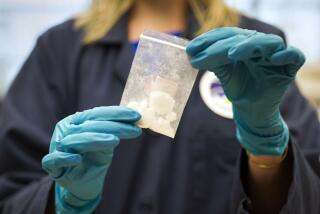More Youths Sniff for High That Can Snuff Life : Health: Inhalant abuse has increased to ‘epidemic proportions,’ experts say. Death and injury can result.
- Share via
It started out like any other Saturday night for the vivacious 15-year-old: lounging on the couch at a friend’s town house, catching a movie on the VCR with several classmates from school. Twice, according to one friend, she stepped outside for a “huff” and popped back in a couple of minutes later. The third time, she didn’t come back.
“Jen’s passed out!” someone yelled, and several teens rushed out, having heard a loud thump as if a body had hit the deck. There the girl lay in her blue jeans, peach shirt and blue Vans sneakers, unconscious, a propane tank hose by her side.
Jennifer Leigh Hoover, a sophomore at Lackey High School in Charles County, Md., died that night last fall of cardiac arrest after inhaling propane gas from an outdoor grill.
In search of a 2-minute high, she added her name to a growing number of young, often middle-class teen-agers who sniff the fumes from aerosol sprays, paint thinner, gasoline and other ordinary household products for cheap, and sometimes deadly, thrills.
Sniffing has been around as long as model-airplane glue and gasoline pumps, but the last few years have witnessed what an article in the New England Journal of Medicine calls abuse “of epidemic proportions.”
An estimated 338,000 U.S. youth ages 12-17 reported sniffing inhalants within the previous month, according to a 1992 study by the National Institute on Drug Abuse.
Another federal survey found that inhalant use is growing. In 1975, 10% of high school seniors reported such behavior; in 1992, 17% did so.
“(Inhalants) are becoming a real popular form of chemical abuse,” said Scott Ellis, a drug counselor in Lincoln, Neb., who worked with three 5-year-olds caught sniffing gasoline out of baby food jars. “A lot of kids and their families don’t see it as doing drugs, but it’s like riding a bike down the hill without your brakes. You may make it and you may not.”
Jennifer’s parents, Nancy and Berk Hoover, didn’t see the crash coming. They say they talked to Jenny several times about illegal drugs, especially after she started smoking an occasional cigarette.
“Oh, Dad,” she’d say to Berk, “I wouldn’t do anything like that.” She even joined the high-school chapter of Students Against Drugs.
“We never even thought there might be something right in the home,” said Nancy, sitting in the cozy kitchen of their small house in Indian Head, Md. “After they’re 10 years old and can read the labels, you don’t talk about the stuff under the sink.”
“I just don’t understand it,” Nancy continued, her eyes filling with tears.
Only Patrick Hoover, Jennifer’s older brother, offered a clue: Jennifer was a curious sort. “She probably saw someone else do it, and it didn’t kill them, so she thought she’d just try it,” he said.
According to Sgt. Robert Cleaveland, the county detective who is investigating Jennifer’s death, she had recently started hanging out with a group of about 20 boys and girls, some of whom began experimenting with propane gas last summer. Propane was only the latest in a number of gases some students had tried, according to several Lackey classmates.
“A lot of kids do Freon,” one boy said during lunch in the school cafeteria a couple of weeks after Jennifer died. “You put it in a plastic bag and breathe in. If you take a hit out of a can, it’ll freeze your lungs.”
“I’ve used propane a little,” said another boy. “Also Freon, nitrous oxide. . . . I did it just to experiment.”
Lauren Diedrich, who drove Jennifer Hoover to the town house that ill-fated night, said her friends get high on inhalants because “it’s fun, like getting drunk or something.” Jennifer told her she liked propane, because “it makes you laugh,” said Lauren, who also said she’d never tried it. “I don’t think she knew it could kill her.”
Young people seek out inhalants because they feel they can control them, said Neil Rosenberg, founder of the International Institute for Inhalant Abuse. “They can sniff just enough and get high, or a lot and hallucinate.”
Lauren Diedrich said Jennifer told her that when she inhaled propane, she’d see “checkers or polka dots.”
Another student said that after a prolonged whiff, the huffer hears “Pac-Man sounds. . . . ‘Wah, wah, wah’ ”
What’s happening to those huffers, said Trent Tschirgi of the University of Maryland School of Pharmacy, is that the chemicals are replacing oxygen in the blood, making the heart beat irregularly and altering breathing. Death can occur instantly (called “sudden sniffing death”) the first time one huffs or the 50th, from cardiac arrhythmia, respiratory failure or a sudden release of adrenaline.
More than 60 American youths died last year from sniffing, according to the inhalant-abuse institute.
Those who don’t die can suffer serious damage. After six months of regular use, the brain, lungs, nerves, liver, kidneys and bones may be permanently damaged, according to the institute’s Rosenberg, a neurologist who has examined dozens of brain scans of serious sniffers.
Abusers may mimic victims of Alzheimer’s disease, suffering from “chronic memory problems (and) major difficulties with reading, writing and arithmetic,” he said. In terms of coordination, “they look like a staggering drunk.” They suffer vision problems and hearing difficulties, and it’s not unusual to see abusers in their 20s wearing hearing aids.
Because the presence of inhalants is not picked up in the routine screening after death, inhalant abuse “has gone largely unreported” in the United States, an article in the New England Journal of Medicine said in December, 1990.
“Our research . . . leads us to believe that abuse of these readily available inhalants has reached epidemic proportions,” authors Earl Siegel and Suman Wason wrote, “indicating an urgent need for preventive efforts directed at teen-agers and their parents, with an emphasis on the risk of sudden death from sniffing.”
More to Read
Sign up for Essential California
The most important California stories and recommendations in your inbox every morning.
You may occasionally receive promotional content from the Los Angeles Times.









